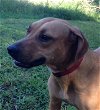 |
Come visit us at our location in Sanford directly behind the Paw Park Dog Park
We are currently open by appointment ONLY.
Click HERE for appointment information.
 |
 |
 |
 |
|
|
Click on any image above for more info.
|
||||
Vizsla / Mixed (short coat) : : Female (spayed) : : Adult : : Medium
|
| My Rescue |
| Login to Remember your Favorite Animals and Breeds! |
About Astrid the Vizsla Mama | |
|
|
Foster Update 9/17/14:
Energy Level She has a low energy level. She will run alongside a bike and go on walks, but otherwise is content to be a couch potato!
Human Social Skills Astrid seems to prefer females, and is cautious around all new people who come into the home. When we have had people over, she remains on her spot on the couch and doesn't interact much at first.
Animal Social Skills While Astrid is cautious around other animals, she is mostly calm. She greets other dogs and allows them to greet her. My dog is very energetic and playful, and while Astrid would rather not partake in her romps, she is comfortable around dogs whose energy is opposite her own.
Personality Astrid is so sweet and loving once you get to know her! I have never seen a dog get so happy just to be approached; even if you just walk by her, her tail starts wagging and she just longs for affection. I have never heard her bark; she only wines when she becomes excited.
Ideal Home A quiet home with calm pack leaders would be best for Astrid. As her energy level is fairly low, she would do well with people who are willing to just "be," and give her the affection she needs.
Astrid is a mix. She has a small petite build. When she first gets to know you she will have a very low energy level, because she's timid. When we first brought her home she laid on the couch and nuzzled her face into the couch. Once she starts to warm up to you she is becoming more and more energetic. I would say she has a moderate to low energy level. Astrid is currently on the Evenger's food, and doesn't mind it. She eats twice a day. (AM + PM) Usually we will set there bowls out and they will munch on it throughout the day. She is fed next to another dog as well as toys, bones, and treats, and has never shown any aggression. She is very timid when you first bring her home, each new situation she is faced with she has slowly but surly learned to adapt too. Perfect example she was terrified of the vacuum when she was first brought to our house and now she doesn't seem to mind it. She just needs constant reassurance until she is confident it will do no harm to her. Since she has been in our home she has not had any problems. She does not chew on the furniture but if you give her a bone she will chew on it. She is also very cautious of new people, although she is getting better she still will not approach a new person. But once she knows the person she has no problems with them approaching her. She has now been with us for a week and is starting to break out of her shell. Now, when we come home and she hears the door she runs off the couch to greet you wagging her tail. Astrid also is wonderful with other dogs. She is more mono-toned but she doesn't mind the company. She has become best friends with our other foster, Georgie. They are learning to tackle there problems together. Astrid is housetrained for the most part, every once in a blue moon if she is not let out she will have an accident but is usually good about going to the door if she has to go potty. She only knows the command sit right now, but we are working on other commands. Astrid would fit best in a home with a couple with little interruptions in there lives. She doesn't mind kids and would most likely do great with another dog to "teach her the ropes" She likes to depend on Georige as to what is safe and unsafe.
Staff Update 12/30/13: Astrid is such a good mama! She is always cleaning them and nuzzling them. She is starting to trust us and will come to us to be pet. We are still working on getting her to walk on the leash. Considering we had to carry her outside the first three days she was here, this is a huge step! I think as she continues to get to know us, she'll find out that people are pretty cool, and she'll be an affectionate, happy dog.
Like many dogs in the South, Astrid is heartworm positive but don't let that stop you from adopting a great dog. We are treating her with monthly heartworm preventative, our preferred method. Many heartworm positive dogs go on to lead long and healthy lives.PRBJtreats ALL of our dogs with monthly Heartworm preventative. HW+ dogs are treated with the recommended slow method, using monthly HW preventative as it is gentler on the animal’s system than the more invasive, injection method. Most dogs that are Heartworm positive can lead healthy, normal lives if the disease is caught early and treatment began. There are different options to treat HW and new owners may choose to redirect their type of treatment with direction of their vet.All HW+ dogs have a HW slow treatment info sheet in their adoption folder which will be provided to new owners.
According to www.dogbreedinfo.com, the Vizsla is a Hungarian hunting dog which probably descended from two ancient breeds: the Transylvanian hound, and the Turkish yellow dog (now extinct). In more recent times, the blood of the German Shorthaired Pointer and the Pointer has been added to the Vizsla. After World War II, the breed was nearly extinct. Hungarians saved some individuals and built the breed up again. After World War II, when Russians took control of Hungary, the native Hungarians feared all the Vizsla would be killed by the Russians, because owning a Vizsla was a symbol of aristocracy. Some devotees smuggled Vizslas out into Austria and to other countries, including America. The name "Vizsla" in Hungarian means, "pointer." The Vizsla is a fine retriever with an excellent nose, and is a good small game and bird hunter and pointer - even on marshy terrain. Loving, demonstrative and gentle, the Vizsla is somewhat willful and distractible, but smart and trainable. This breed needs a patient, firm hand. They are reliable with children, loving all the play they can get. Maybe to too energetic and excitable for very young toddlers, excellent for energetic kids. Able to adapt quickly to family life, and are generally good with other dogs. Energetic and athletic, the Vizsla must receive sufficient exercise or they may become destructive or neurotic. Socialize this dog well and get him accustomed to noises at an early age. It is very important to obedience train your Vizsla. They can get overly eager, prancing around you in sheer excitement. This breed is highly trainable and very willing to please; if you can get it to understand exactly what it is you want of them. If you do not train this breed they may become difficult to handle and control. Vizsla are known as chewers. This breed is not for everyone. If you want a calm dog and are not willing to walk a couple of miles or jog at least one mile a day, do not choose a Vizsla. Without proper exercise, the can easily become high strung. They have many talents such as: tracking, retrieving, pointing, watchdog and competitive obedience. The Vizsla is a hunting dog and may be good with cats they are raised with, but should not be trusted with animals such as hamsters, rabbits and guinea pigs etc... The Vizsla is not recommended for apartment life. It is moderately active indoors and does best with at least an average-sized yard. This is an energetic working dog with enormous stamina. They need to be taken on daily, long, brisk walks or jogs. In addition, it needs plenty of opportunity to run, preferably off the leash in a safe area. If these dogs are allowed to get bored, and are not walked or jogged daily, they can become destructive and start to display a wide array of behavioral problems. They have a life expectancy of 12-15 years.
More about Astrid the Vizsla Mama
Other Pictures of Astrid the Vizsla Mama (click to see larger version):








Copyright © Pet Rescue by Judy






